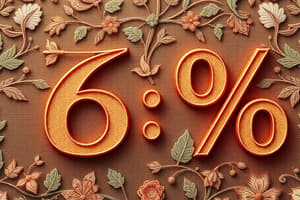Podcast
Questions and Answers
What is the first step to finding 10% of $100?
What is the first step to finding 10% of $100?
- Divide 10 by $100
- Multiply 10 by $100
- Convert 10% to a decimal (0.10) (correct)
- Subtract 10 from $100
A 20% discount on an item means the item's price is reduced by:
A 20% discount on an item means the item's price is reduced by:
- 25% of its original value
- 10% of its original value
- 15% of its original value
- 20% of its original value (correct)
If a population grows by 5% annually, what term is commonly used to describe this growth?
If a population grows by 5% annually, what term is commonly used to describe this growth?
- Percentage increase (correct)
- Multiplicative reduction
- Percentage decrease
- Additive growth
What purpose do percentages serve in describing probability?
What purpose do percentages serve in describing probability?
Which area often uses percentage returns to measure investment growth?
Which area often uses percentage returns to measure investment growth?
To calculate 15% of a number, you should:
To calculate 15% of a number, you should:
How do you find a percentage increase?
How do you find a percentage increase?
What is the first step to calculate a percentage of a number?
What is the first step to calculate a percentage of a number?
If a product's price decreased from $80 to $60, what is the percentage decrease?
If a product's price decreased from $80 to $60, what is the percentage decrease?
What is the final step to find a percentage of a number?
What is the final step to find a percentage of a number?
If you want to find 15% of 200, what is the result?
If you want to find 15% of 200, what is the result?
What is the key difference between finding a percentage increase and finding a percentage decrease?
What is the key difference between finding a percentage increase and finding a percentage decrease?
Flashcards are hidden until you start studying
Study Notes
Calculating Percentages
In everyday life, we often encounter percentages as a way to express proportional changes or relationships. Understanding and working with percentages can be crucial in various situations, from simple school problems to complex financial calculations. Here, we'll delve into the basics of working with percentages, starting with how to calculate them.
To calculate a percentage of a number, follow these steps:
- Convert the percentage to a decimal by dividing by 100. For example, 5% becomes 0.05.
- Multiply the decimal by the original number.
For instance, if you want to find 10% of 150, you'll first convert 10% to a decimal, which is 0.10, and then multiply it by 150, resulting in 15.
Percentage Increase and Decrease
Increase and decrease percentages represent how much a quantity has changed compared to its original value.
- To find a percentage increase, subtract the original value from the new value, then divide the difference by the original value and multiply by 100.
- To find a percentage decrease, follow the same steps but make the difference a negative value.
For example, if the price of a product increased from $50 to $60, the percentage increase would be (60 - 50) / 50 * 100 = 20%.
Percentage of a Number
To find a percentage of a number, you can follow the same steps as before but include the original number in the calculation.
- Convert the percentage to a decimal.
- Multiply the decimal by the original number.
For instance, if you want to find 10% of $100, you'll first convert 10% to a decimal, which is 0.10, and then multiply it by 100, resulting in $10.
Applications of Percentages
Percentages are employed in numerous practical applications, such as:
- Discounts: A 20% discount on an item means that the item's price is reduced by 20% of its original value.
- Tips: Tips are often expressed as a percentage of the total bill, making calculations easier.
- Growth rates: Percentages are used to describe how much a population, economy, or other quantities are growing or shrinking over time.
- Probability: Percentages can be used to express probabilities, like the chances of winning a game or an election.
- Investments: Percentage returns help investors measure the growth in their investments.
In conclusion, understanding and working with percentages is essential in everyday life. By learning the basic calculations and knowing where percentages are used, you can better navigate and make informed decisions in various contexts.
Studying That Suits You
Use AI to generate personalized quizzes and flashcards to suit your learning preferences.




